A dining room is where people gather to enjoy meals and socialize. It can vary in size, functionality, and style depending on the preferences and needs of the homeowners. Some dining rooms are formal and elegant, while others are casual and cozy. The size of a dining room depends on the number of people who use it and the available space in the house. A typical dining room can comfortably accommodate 6 to 8 people, but some can fit more or less. The size of the dining table, chairs, and other furniture also affects the size of the dining room. The functionality of a dining room is determined by how often and for what purposes it is used. Some dining rooms are used only for special occasions like holidays, birthdays, or anniversaries, while others are used daily for family meals, homework, or work. Some dining rooms can also serve as multipurpose rooms, such as living rooms, libraries, or offices. The furniture and renovation of the dining room reflect the style and personality of the homeowners. Some dining rooms have traditional furniture, such as wooden tables, chairs, and cabinets, while others have modern furniture, such as glass tables, metal chairs, and minimalist shelves. A dining room’s color, lighting, and decoration can enhance its ambiance and mood.
What is the typical size of a dining room?
The typical size of a dining room is 129 square feet (12 square meters) to 215 square feet (20 square meters). The size of the dining room should allow for comfortable movement and seating around the dining table. In a space measuring 129 square feet (12 square meters), a rectangular table with 4 to 6 people can fit well, along with additional space for chairs and circulation. A larger rectangular or round table with 6 to 8 people can accommodate larger dining rooms measuring 215 square feet (20 square meters). The size of a dining room can vary based on personal preferences, the number of occupants in the household, and the available space within the overall floor plan. Homeowners should also consider factors like the room’s shape, the placement of windows and doors, and any additional furniture or storage needs when determining the ideal size of their dining room.
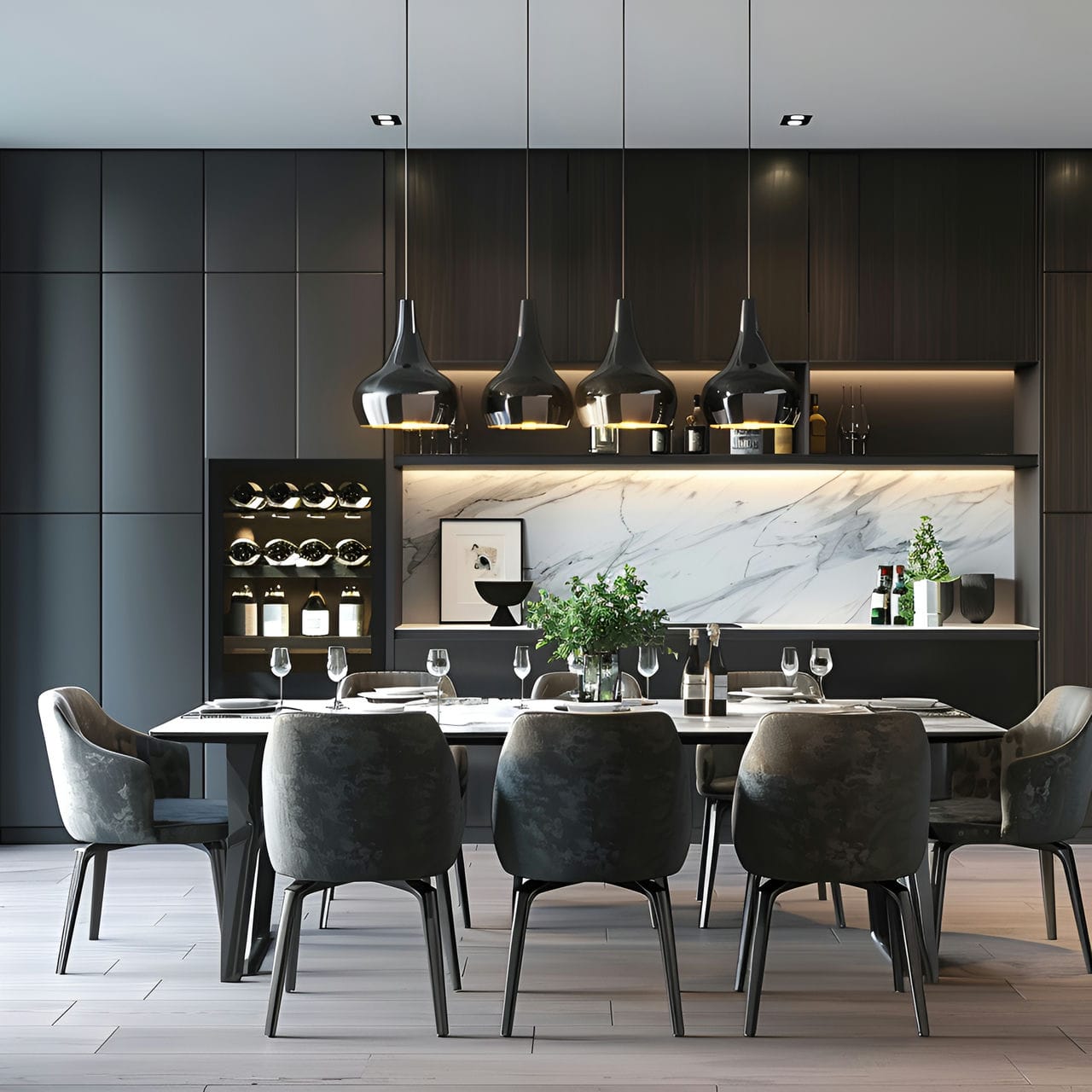
What is the use and purpose of a dining room?
The use and purpose of a dining room are a dedicated space for dining, promotes family bonding and social gatherings, and offers versatility for various activities. Firstly, the primary use of a dining room is for dining and enjoying meals. It provides a centralized location within the home where family members or residents can gather to eat together. The dining table and chairs are the focal point, providing a comfortable and convenient setting for individuals to sit down, share meals, and engage in conversation. The dining room creates an environment that encourages regular family meals, fostering communication and strengthening relationships. Secondly, a dining room also hosts social gatherings and entertains guests. Whether it is a dinner party, holiday celebration, or special occasion, the dining room offers an area specifically designed to accommodate larger groups of people. It provides an appropriate setting for serving meals, engaging in conversations, and creating memorable experiences. The dining room’s layout and furniture arrangement are often chosen to facilitate social interactions and create a warm, inviting ambiance. Lastly, a dining room can also be versatile for various activities beyond dining. It can function as a home office or study area, where individuals can work or engage in tasks that require a dedicated workspace. The dining room can also be used for hobbies, such as crafting, board games, or additional seating when entertaining. Its flexibility allows homeowners to adapt the space according to their needs and utilize it beyond traditional dining.
What is the typical shape of a dining room?
The typical shape of a dining room is rectangular. It is commonly observed to have a length of 13 feet (4 meters) to 16 feet (5 meters) and a width of 10 feet (3 meters) to 13 feet (4 meters). The rectangular shape is favored as it allows for efficient dining furniture placement and facilitates easy movement within the space. The dining room usually features a simple layout, with a table positioned at the center. The table dimensions can vary, but a standard dining table typically measures 3 feet (1 meter) to 5 feet (1.5 meters) in width and 6 feet (1.8 meters) to 8 feet (2.4 meters) in length. This provides ample space for seating and accommodating dining essentials.
What furniture commonly equips a dining room?
Listed below are the types of furniture commonly equip a dining room:
- Dining table: A dining room is typically equipped with a dining table, which is the central furniture piece. It provides a surface for placing food, utensils, and dishes during meals. The standard dining table dimensions range from 3 feet (1 meter) to 5 feet (1.5 meters) in width and 6 feet (1.8 meters) to 8 feet (2.4 meters) in length, accommodating multiple diners.
- Dining chairs: Dining rooms commonly feature a set of dining chairs surrounding the dining table. These chairs provide comfortable seating for individuals during mealtime. The number of chairs typically corresponds to the seating capacity of the dining table.
- Sideboard or buffet: A sideboard or buffet is often found in dining rooms, offering additional storage and serving space. These furniture pieces can store table linens, dinnerware, and other essentials. They also serve as surfaces for placing prepared dishes or displaying decorative items.
- Display cabinet: Some dining rooms may include a display cabinet, also known as a china cabinet or hutch. This furniture piece showcases fine china, glassware, or other collectibles. It adds a decorative element to the dining room while providing storage and display options.
- Bar cart: A bar cart is a popular addition to dining rooms, especially for those who enjoy entertaining guests. It offers a convenient way to store and display beverages, glassware, and bar accessories. The mobile nature of a bar cart allows for easy serving and can be moved around as needed.
- Lighting fixtures: Adequate lighting is essential in a dining room. Common lighting fixtures include pendant lights, chandeliers, or ceiling-mounted fixtures. These provide overall illumination to the space, creating a welcoming atmosphere for dining.
- Rug: Rugs are often used in dining rooms to define the space and add warmth. A rug beneath the dining table helps anchor the furniture and provides a comfortable surface for diners’ feet.
- Wall decor: Wall decor, such as artwork or mirrors, can enhance the aesthetics of a dining room. It adds visual interest and can tie the room’s design together, creating a cohesive look.
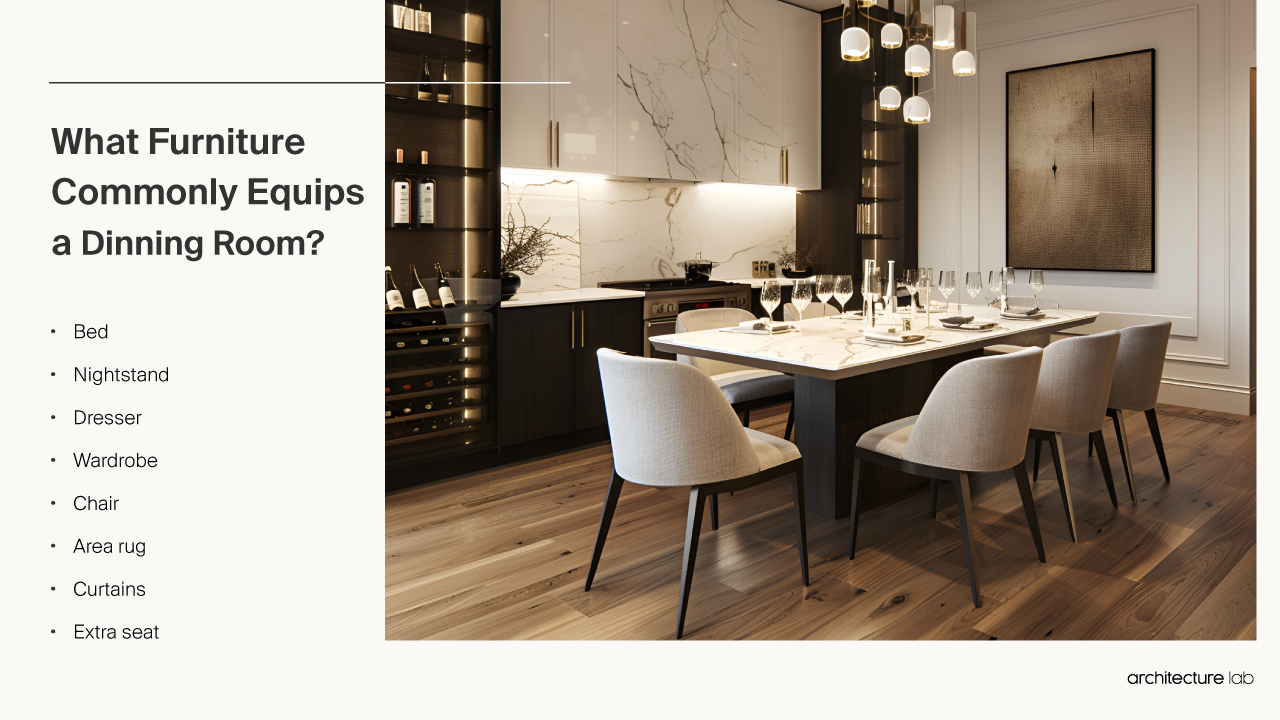
What is the normal ceiling height of a dining room?
The normal ceiling height of a dining room is 8 feet (2.4 meters) to 10 feet (3 meters). This height provides a comfortable and spacious feel to the room while allowing for proper air circulation and accommodating standard-sized furniture pieces. A ceiling height of 8 feet (2.4 meters) is considered the minimum acceptable height for a dining room, ensuring occupants do not feel cramped or restricted in their movements, but a ceiling height of 10 feet (3 meters) or slightly higher is often preferred as it creates a more open and airy ambiance. The ceiling height in a dining room plays a crucial role in the overall aesthetics and functionality of the space. It affects the acoustics, allowing sound to disperse evenly throughout the room. A higher ceiling can provide opportunities for decorative elements such as chandeliers or pendant lights to be installed, adding visual interest and enhancing the overall design of the dining room.
What colors are dining rooms usually painted?
Listed below are the colors dining rooms usually painted:
- Earth tones: Earthy colors such as shades of brown, taupe, or terracotta can create a warm and grounded atmosphere in a dining room. These colors are often associated with nature and can provide comfort and relaxation.
- Soft pastels: Soft pastel colors like pale pink, light blue, or mint green can give a dining room a delicate and airy feel. These colors are often used in spaces where a light and feminine aesthetic is desired.
- Dark and moody shades: Some dining rooms opt for darker, more dramatic colors such as deep navy blue, rich charcoal gray, or dark green. These colors can create a sophisticated and intimate atmosphere, particularly in formal dining rooms or spaces where a sense of luxury is desired.
- White and off-white: White and off-white colors are timeless and versatile choices for dining rooms. They can create a clean and fresh look, allowing other elements in the room to stand out. White walls can also make the space more open and spacious, benefiting smaller dining rooms.
- Bold and lively colors: Dining rooms embrace bold, lively colors like red, orange, or yellow. These colors can energize the space and create a lively and stimulating atmosphere, but using these colors in moderation is important to avoid overwhelming the senses.
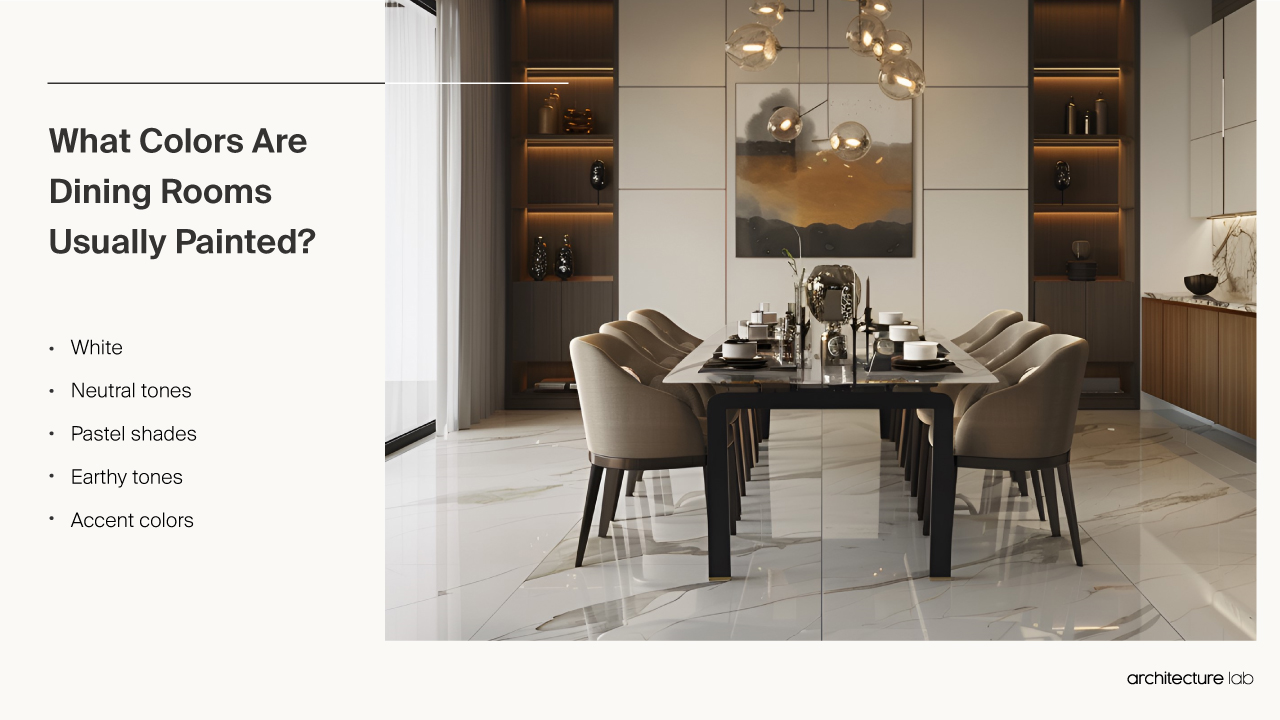
What makes the dining room functional?
The dining room is functional through adequate space, proper lighting, storage and organization solutions, and comfortable seating. These elements contribute to a comfortable, well-lit, and organized space that promotes ease of movement, visibility, and overall enjoyment during meals. Firstly, a dining room should have enough space to comfortably accommodate the dining table and chairs. The size of the dining room should allow for easy movement and accessibility around the table, ensuring that diners can sit and move around without feeling cramped or restricted. Secondly, good lighting is crucial in a dining room to create a pleasant and functional environment. Sufficient natural or artificial lighting should be provided to ensure visibility during meals. Adjustable lighting fixtures, such as dimmer switches or pendant lights with adjustable heights, allow for flexibility in setting the desired ambiance for different occasions. Thirdly, an organized dining room contributes to its functionality. Adequate storage solutions, such as sideboards, buffets, or display cabinets, help keep dining essentials, such as table linens, dinnerware, and glassware, neatly stored and easily accessible. This reduces clutter on the dining table and allows for efficient use of the space. Lastly, the dining chairs should be comfortable and ergonomically designed to support proper posture during meals. Cushioned seats and appropriate back support enhance diners’ comfort, making the dining experience more enjoyable. The number of chairs should correspond to the seating capacity of the dining table to accommodate all occupants.
How is energy efficiency achieved in a dining room?
Energy efficiency is achieved in a dining room through energy-efficient lighting, proper insulation, efficient HVAC systems, energy-efficient appliances, and smart energy management practices. Firstly, using energy-efficient lighting fixtures such as LED bulbs or compact fluorescent lamps (CFLs) can significantly reduce energy consumption. These bulbs consume less electricity and have a longer lifespan than traditional incandescent bulbs. Utilizing natural light through well-placed windows or skylights can minimize the need for artificial lighting during the daytime. Secondly, proper insulation in the dining room helps maintain a comfortable temperature and reduces the need for excessive heating or cooling. Insulating the walls, ceiling, and floors helps prevent heat loss during colder months and heat gain during warmer months. This can be achieved through insulation batts, foam insulation, or double-glazed windows. Thirdly, installing energy-efficient heating, ventilation, and air conditioning (HVAC) systems can contribute to energy efficiency in the dining room. High-efficiency HVAC units with programmable thermostats allow precise control over temperature settings, reducing energy waste. Regular maintenance and cleaning of HVAC systems also ensure optimal performance and energy efficiency. Lastly, choosing energy-efficient appliances for the dining room, such as refrigerators, dishwashers, or ovens, can significantly reduce energy consumption. Look for appliances with ENERGY STAR labels, as they meet certain energy efficiency standards the Environmental Protection Agency (EPA) set. These appliances are designed to minimize greenhouse emissions while delivering optimal performance.
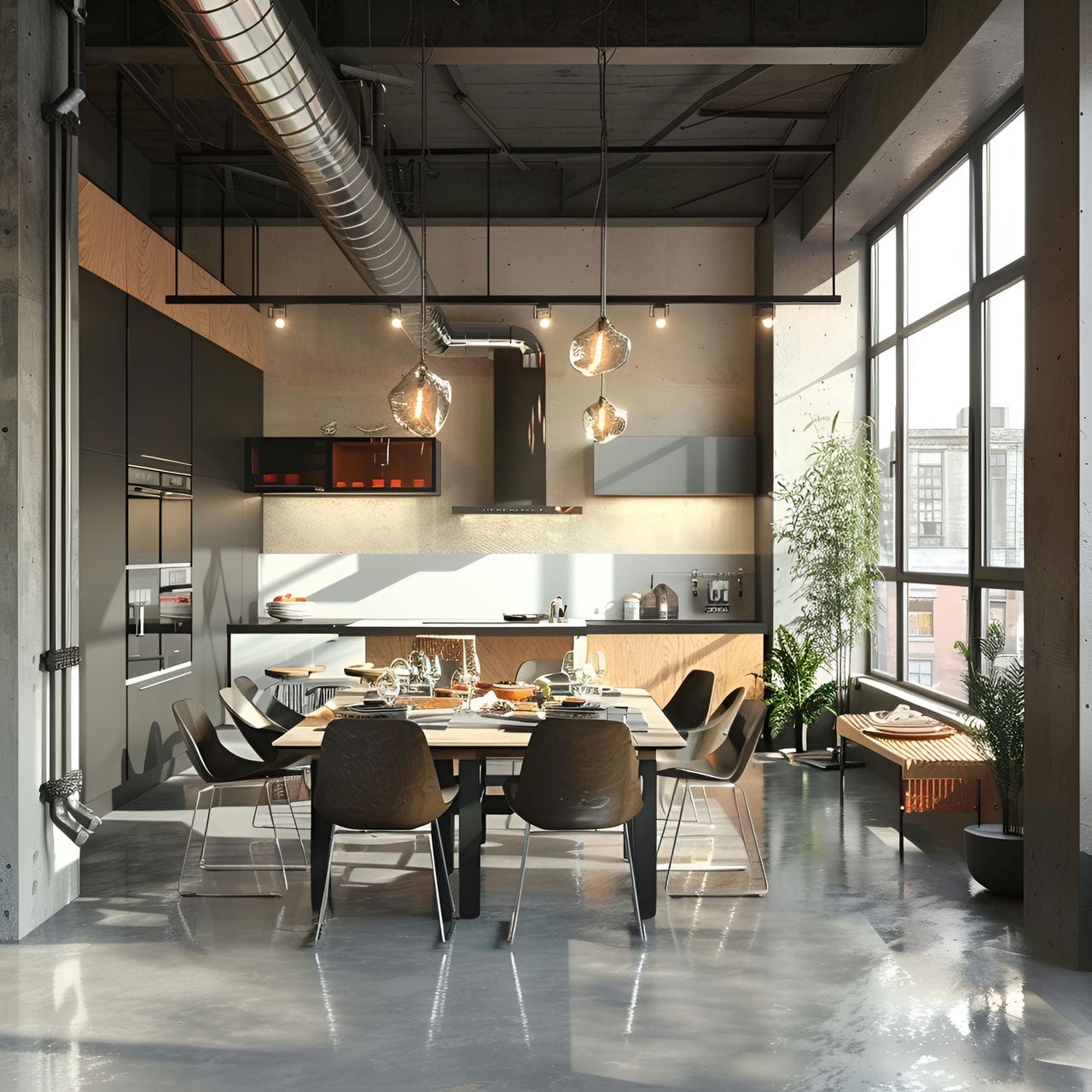
How much does it typically cost to renovate a dining room?
It typically costs $5,000 (€4,550, £4,350) to $15,000 (€13,650, £13,050) or more to renovate a dining room. The cost of renovating a dining room depends on factors such as the size of the room, the extent of changes needed, and the materials and finishes chosen. The cost can be on the lower end of the range for minor updates such as repainting the walls, replacing light fixtures, or updating furniture, while a major renovation involving structural changes, flooring replacement, custom cabinetry, or high-end finishes can increase the cost significantly. Additional costs to consider when renovating a dining room include hiring professionals such as contractors, electricians, or painters and obtaining necessary permits.
What factors affect the dining room renovation?
Listed below are the factors that affect the dining room renovation:
- Budget: The available budget plays a significant role in determining the scope and quality of the dining room renovation. It determines the materials, finishes, and extent of changes that can be made within the allocated funds.
- Size of the room: The size of the dining room affects the overall renovation cost. Larger rooms require more materials and may involve additional labor costs for painting, flooring, or installing fixtures.
- Structural changes: Any dining room structural changes, such as removing walls or adding windows, can impact the complexity and cost of the renovation. Structural modifications often require the expertise of professionals and may involve obtaining permits.
- Desired style and design: The chosen dining room style and design preferences influence the selection of materials, finishes, furniture, and lighting fixtures. Different styles have varying prices, and high-end materials or custom designs can increase the overall cost.
- Electrical and plumbing requirements: If the dining room renovation involves changes to electrical wiring or plumbing fixtures, it can add to the expense. Hiring licensed electricians and plumbers ensures compliance with safety standards and local building codes.
- Lighting needs: Lighting is an important aspect of a dining room. The type of lighting desired, such as recessed lights, pendant lights, or chandeliers, can impact the cost. Incorporating energy-efficient lighting solutions may require an initial investment but can result in long-term savings.
- Flooring choices: The selection of dining room flooring materials, such as hardwood, laminate, tile, or carpet, affects both the aesthetics and cost of the renovation. Higher-quality materials are more expensive, while low-maintenance options may have a higher upfront cost but lower long-term expenses.
- Customization and special features: Incorporating custom features, such as built-in cabinetry, wine racks, or unique architectural elements, can add to the cost. These customizations often require skilled craftsmen or specialized materials, contributing to the budget.
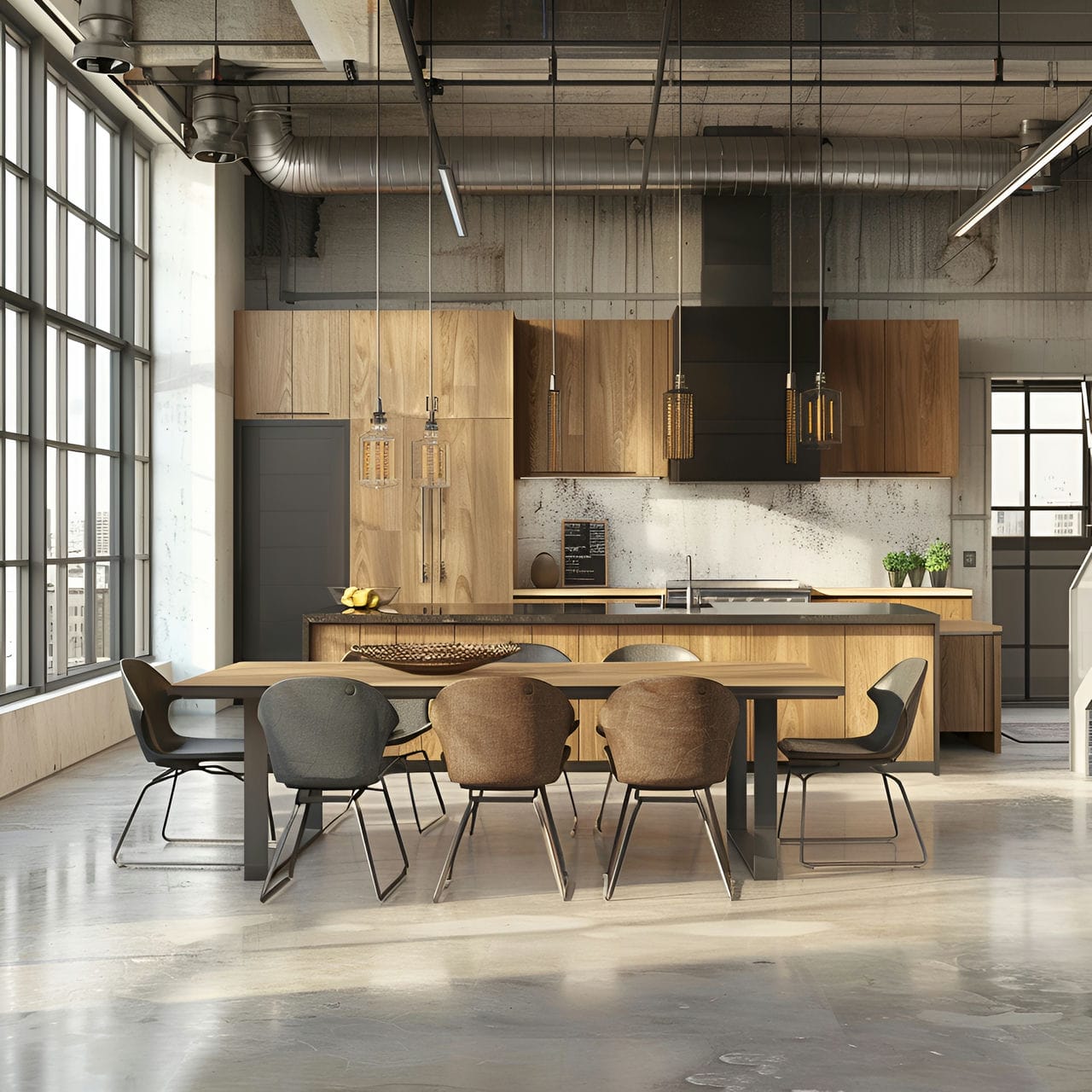
Is an architect required to renovate a dining room?
No, an architect is not required to renovate a dining room, but it is highly advised. An architect possesses the expertise and knowledge to assess the structural integrity of the space and provide professional guidance. They can evaluate the feasibility of design ideas and propose practical solutions for any potential challenges during the renovation process. An architect can help translate a homeowner’s vision into a well-designed space that maximizes functionality and aesthetics. They have a keen eye for detail and can create a cohesive design concept that complements their style and preferences. Their space planning and arrangement expertise can optimize the dining room’s layout, ensuring efficient use of available space.
How can an architect help you upgrade a dining room?
Listed below are the ways that an architect can help an owner upgrade a dining room:
- Space planning: An architect can analyze the existing layout and propose efficient space planning strategies to optimize the functionality of the dining room. They can suggest the best arrangement of furniture, fixtures, and circulation paths to maximize comfort and usability.
- Design concept: Architects can assist in developing a cohesive design concept for the dining room upgrade. They consider the owner’s preferences, architectural style, and desired atmosphere to create a visually appealing and harmonious space.
- Material and finish selection: Architects know the various materials and finishes available. They can recommend options that align with the owner’s dining room aesthetic preferences, durability requirements, and budget constraints.
- Lighting design: Proper lighting is essential in a dining room to create the desired ambiance and highlight architectural features or focal points. Architects can design a lighting scheme incorporating natural and artificial lighting sources to enhance the dining experience.
- Customization: If the owner desires custom features or unique architectural elements, an architect can help translate those ideas into practical dining room designs. They can collaborate with craftsmen and contractors to ensure accurate implementation of customizations.
- Building codes and regulations: Architects are well-versed in local building codes and regulations. They can ensure the dining room upgrade complies with all applicable codes, including safety measures, accessibility requirements, and fire regulations.
- Project management: Architects can oversee the dining room renovation project as a liaison between the owner and contractors. They can create detailed drawings, specifications, and construction documents and coordinate the work of various professionals to ensure a smooth and successful project execution.
- Value engineering: Architects can provide value engineering solutions to optimize the project’s cost without compromising quality. They can suggest cost-effective alternatives, identify areas where savings can be achieved, and help the owner make informed decisions regarding budget allocation for renovating the dining room.
How much does it cost to hire an architect to renovate a dining room?
It costs $1,500 (€1,365, £1,305) to $8,000 (€7,280, £6,960) or more to hire an architect to renovate a dining room. The extent of the architect’s involvement in the project, such as initial design concepts, detailed drawings, construction administration, and project management, can impact the overall cost. Renovations involving structural changes, custom features, or specialized design elements may require additional architectural expertise and thus result in higher fees. Larger dining rooms may require more time and effort from the architect, leading to higher fees, while smaller dining rooms may have lower architectural fees.
Is it worth it to hire an architect to upgrade a dining room?
Yes, it is worth it to hire an architect to upgrade a dining room. Architects bring specialized knowledge and expertise to the table. They understand the principles of design, space planning, and functionality. Their understanding of structural integrity and building codes ensures the dining room upgrade is safe and compliant. Hiring an architect means having a professional to manage the entire renovation process. They can create detailed drawings, collaborate with contractors, and oversee the construction to ensure the project is executed according to plan. Their project management skills save time, reduce stress, and help avoid costly mistakes.
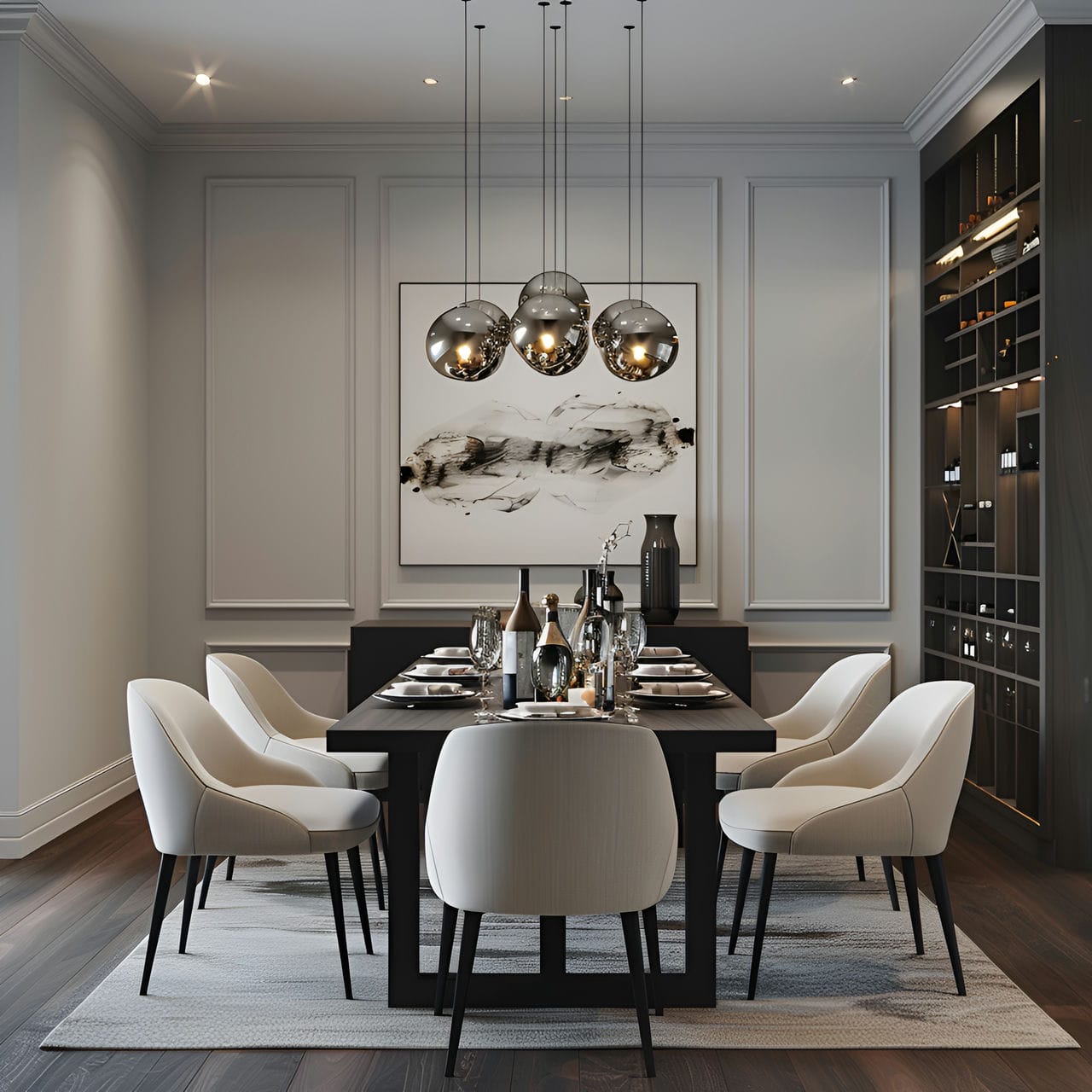
How long is needed to redecorate a dining room?
To redecorate the dining room, a timeframe of 2 weeks to 4 weeks is needed. The first phase involves planning, design conceptualization, and material selection. This phase can take 5 days to 1 week, depending on the owner’s decision-making process and the involvement of an architect or interior designer. The construction phase includes painting, flooring installation, lighting fixture replacement, furniture assembly, and other necessary installations. This phase typically takes the longest, ranging from 1 to 3 weeks, depending on the extent of the renovation and the dining room’s size. Once the major construction work is completed, the final phase involves adding finishing touches such as window treatments, artwork, accessories, and decorative elements. This phase usually takes 6 days to 1 week, depending on the owner’s preferences and the availability of the desired items. Unforeseen delays such as weather conditions, availability of contractors, or unexpected issues during the renovation process can extend the overall duration. It is advisable to account for some buffer time to accommodate any unexpected delays.
What are the struggles of the homeowner to redecorate a dining room?
Listed below are the struggles of the homeowner to redecorate a dining room:
- Budget constraints: Homeowners may struggle with setting a budget for the dining room redecoration project. Costs for materials, furniture, fixtures, and professional services can add up quickly, requiring careful financial planning and decision-making.
- Lack of design expertise: Many homeowners may lack the knowledge and skills to create a cohesive and aesthetically pleasing dining room. Choosing appropriate colors, textures, and furniture to complement each other can be challenging without professional guidance.
- Time constraints: Redecorating a dining room can be time-consuming, especially for homeowners with busy schedules. Finding the time to research options, shop for materials, coordinate with contractors, and oversee the project can be a struggle.
- Decision-making: Homeowners may face difficulties deciding on dining room design choices, such as paint colors, furniture styles, or lighting fixtures. Making choices that align with personal preferences and the desired aesthetic can be overwhelming.
- Coordination with contractors: Coordinating with contractors and tradespeople can be challenging for homeowners, especially if they have limited experience managing dining room construction or renovation. Scheduling conflicts, communication issues, and ensuring quality workmanship can all be sources of frustration.
- Limited access to resources: Homeowners may face challenges accessing resources such as reliable suppliers, contractors, or skilled craftsmen. Limited availability of certain materials or professionals in their area can impact the progress and outcome of the dining room redecoration.
- Unexpected issues: During the dining room redecoration process, unexpected issues may arise, such as hidden structural problems, electrical issues, or plumbing concerns. These unforeseen challenges can be stressful and require additional time and financial resources.
- Emotional attachment: Homeowners may struggle with letting go of sentimental items or furniture that no longer fit the desired aesthetic or functionality. Making decisions about what to keep, what to discard, and what to replace can invoke emotional attachments, making the dining room renovation more challenging.


